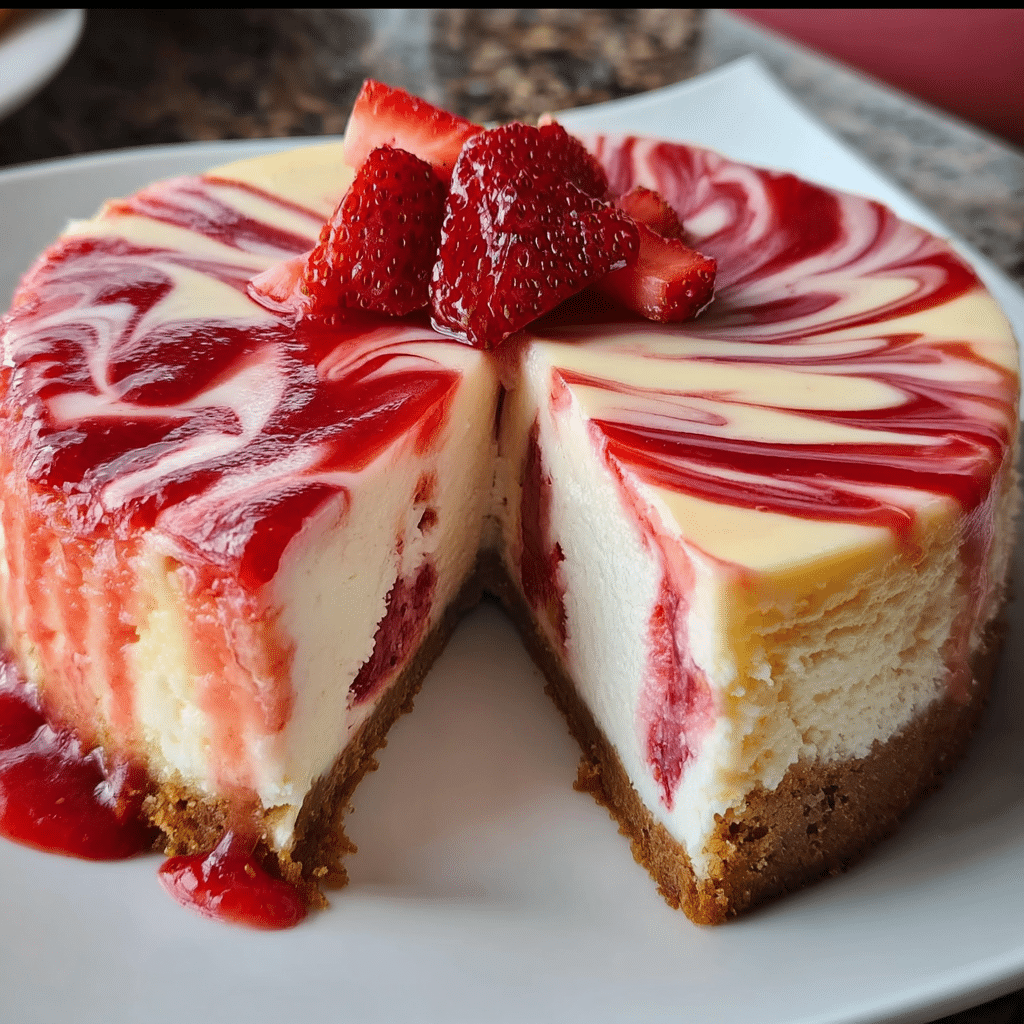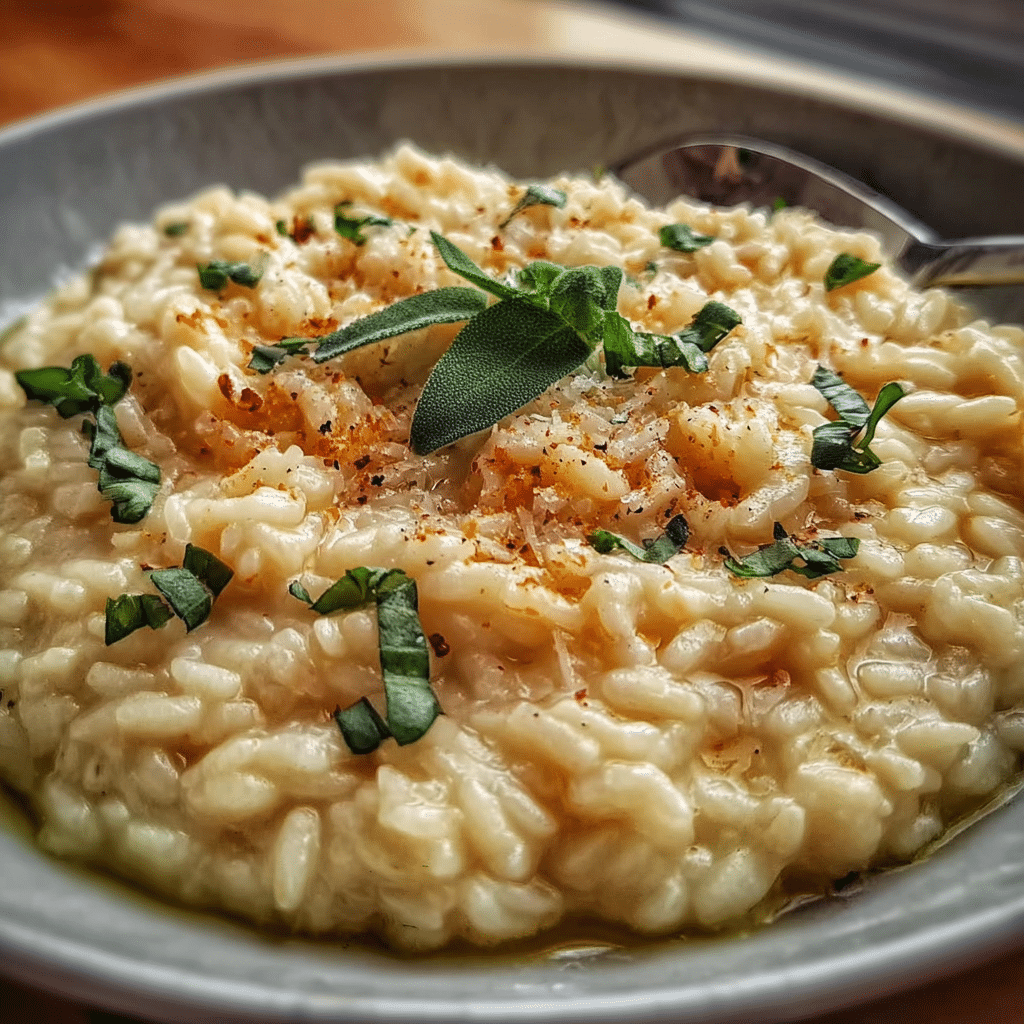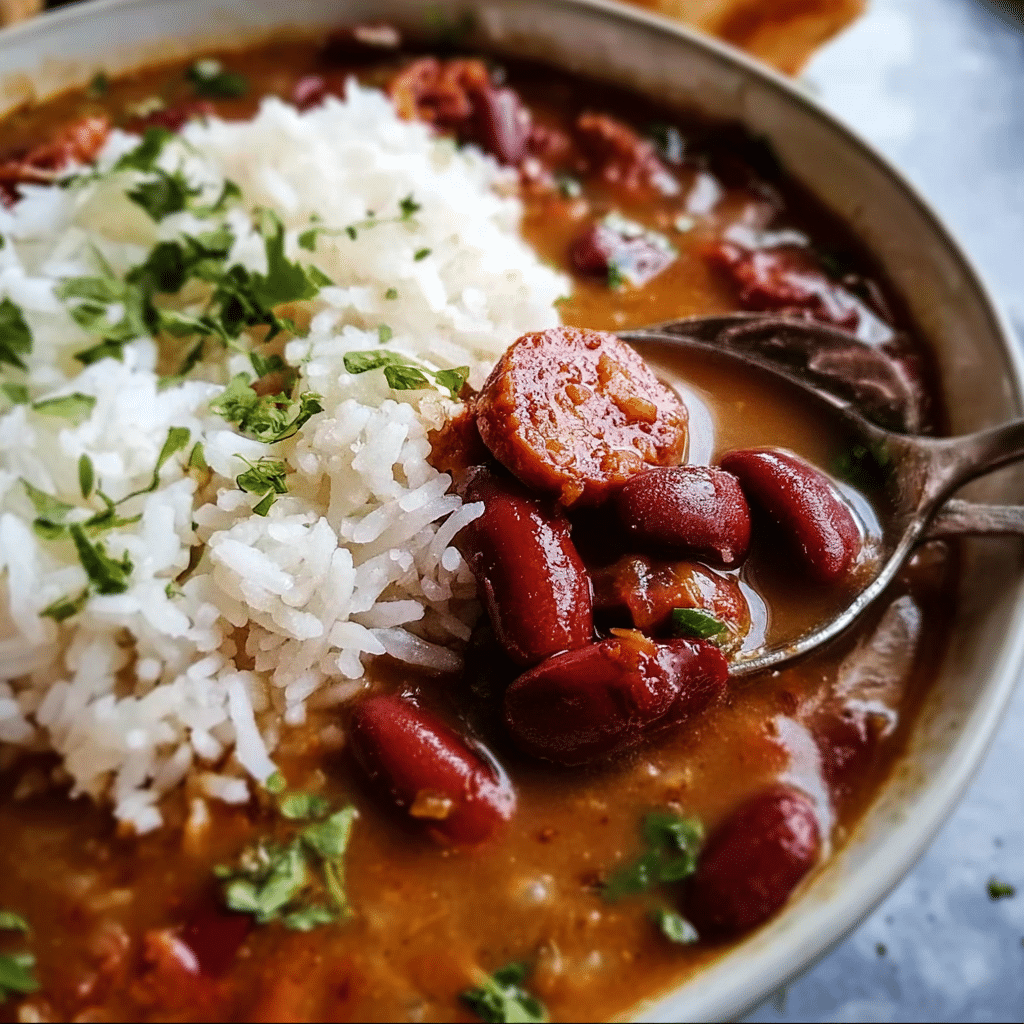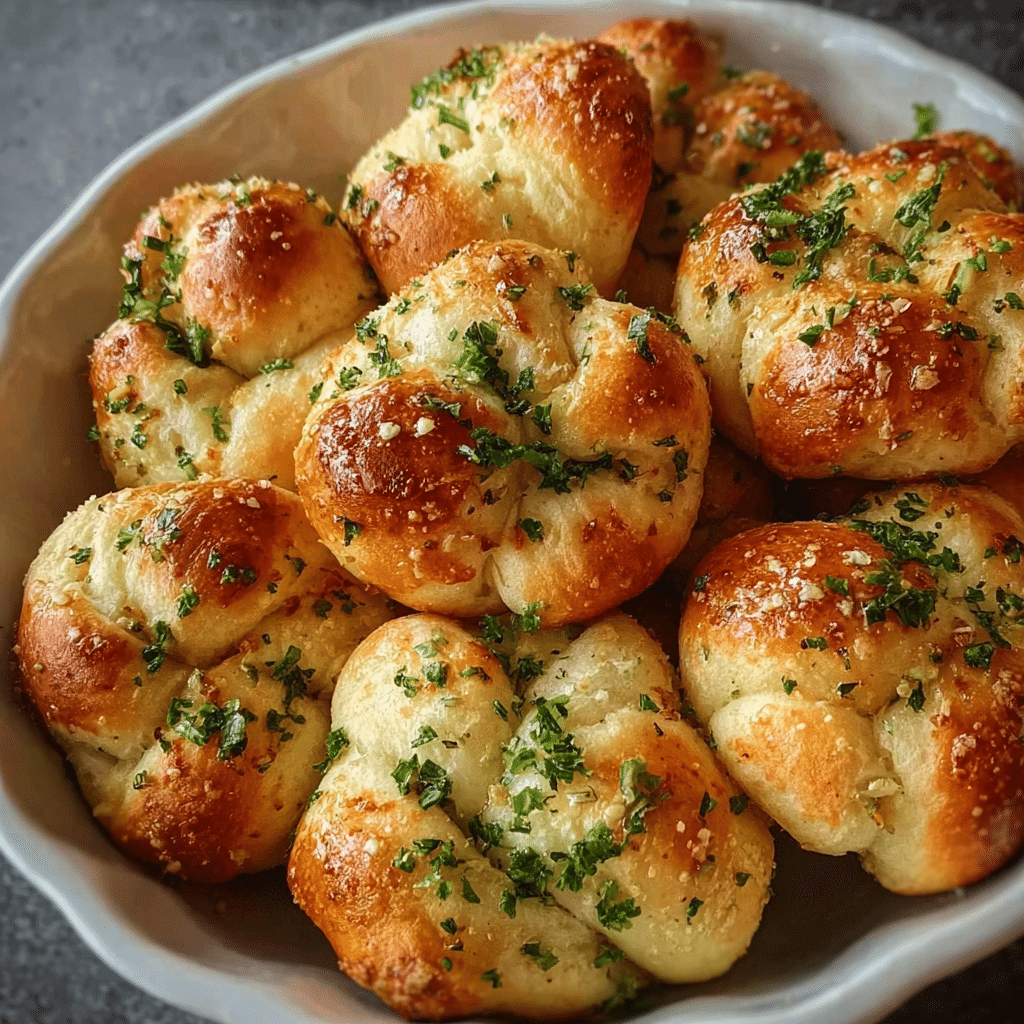Sweet potato casserole is more than just a side dish; it’s a warm hug on a plate, a nostalgic reminder of family gatherings, and a delightful blend of flavors that brings joy to any table. My first encounter with this delectable dish happened on a chilly Thanksgiving afternoon at my grandmother’s house. The scent of cinnamon, nutmeg, and sweet potatoes wafted through the air, enveloping me in a comforting embrace as I entered the kitchen. I remember peeking into the oven, my eyes widening at the sight of the golden marshmallows bubbling atop a luscious layer of sweet potato puree. It was love at first sight! Little did I know that this sweet potato casserole would become a staple in my own cooking repertoire, a dish I would cherish and pass down to my children.
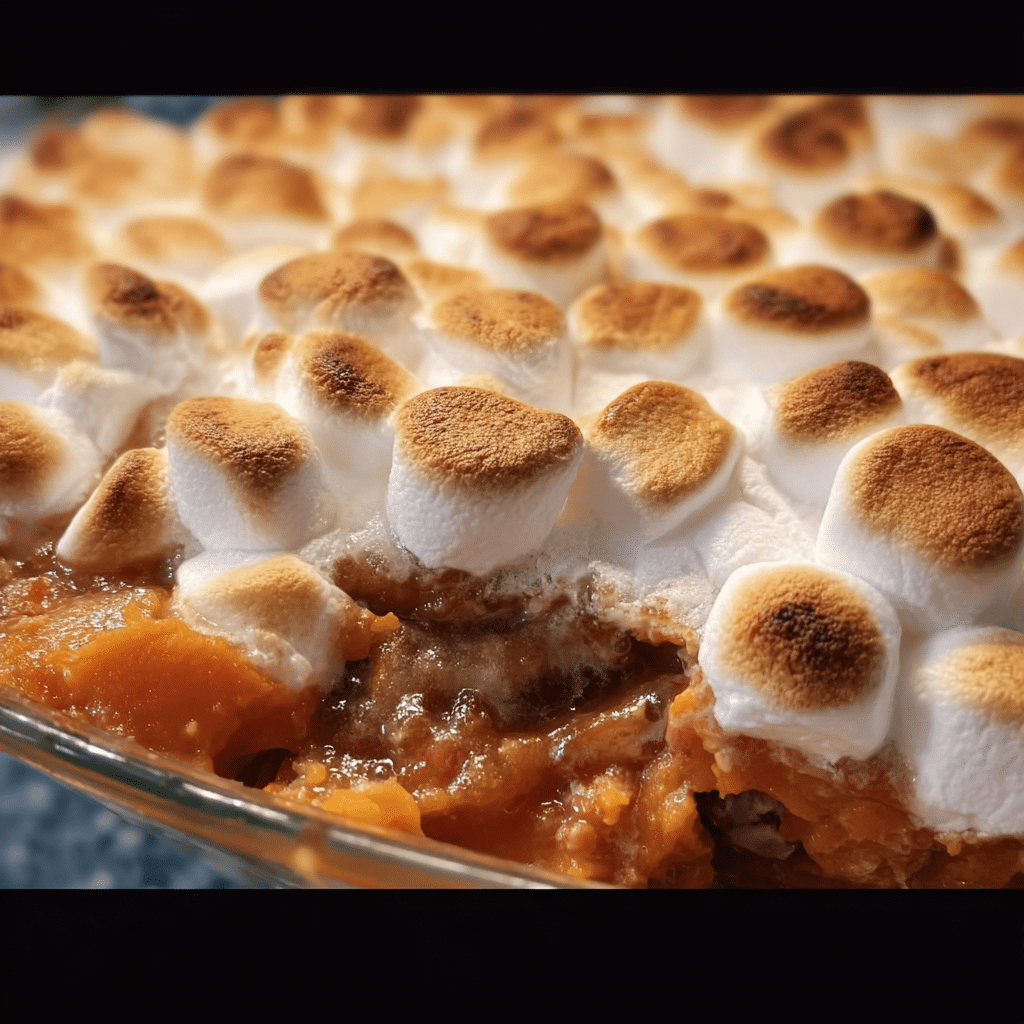
The Story Behind This Recipe
As I helped my grandmother prepare the sweet potato casserole, she shared stories of her childhood in the South, where sweet potatoes were a common crop, especially in the fall. She would recount how her mother would bake sweet potatoes and whip them with sugar, butter, and spices, creating a creamy filling that would later be topped with marshmallows. This culinary tradition was rooted deeply in the agricultural practices of the region, where sweet potatoes were not only plentiful but also a staple food for many families. The combination of sweet and savory is a hallmark of Southern cooking, and this dish is a prime example of how simplicity can lead to extraordinary flavors.
What makes this sweet potato casserole special, compared to others, is the balance of flavors and textures. The creaminess of the sweet potatoes pairs beautifully with the crunchy, toasted marshmallows on top, creating a delightful contrast that dances on your palate. While some may prefer a more traditional approach with pecans or a streusel topping, my grandmother’s recipe has always held a special place in my heart. It’s a celebration of simplicity and the love of good home-cooked food.
This recipe is perfect for busy families looking for quick dinner solutions, as it can be prepared ahead of time and simply baked before serving. With just a handful of ingredients and minimal prep work, sweet potato casserole is an excellent option for weeknight dinners or holiday feasts. You can even make it the day before, allowing the flavors to meld beautifully overnight, ensuring a richer taste when it’s finally baked. As the holidays approach, this dish becomes even more relevant, serving as a comforting side that pairs wonderfully with turkey and stuffing.
Sweet potato casserole holds a special emotional connection for many, including myself. It symbolizes family gatherings, warmth, and the joy of sharing a meal with loved ones. Each bite is reminiscent of laughter around the dinner table, the clinking of silverware, and stories shared over plates filled with love. It’s not just food; it’s a memory, a tradition, and a way to connect with my roots, reminding me of the importance of family and the joy of togetherness.
In this guide, you will learn everything you need to know about sweet potato casserole, from its rich history and cultural significance to tips on how to perfect your own version of this beloved dish. Whether you’re a seasoned cook or a novice in the kitchen, I promise this guide will equip you with the knowledge and inspiration to create a sweet potato casserole that is not only delicious but also a tribute to the traditions that have shaped this remarkable dish.
The Rich History and Cultural Significance of sweet potato casserole
The rich history and cultural significance of sweet potato casserole are as deep and complex as the flavors that define it. Understanding the origins of this beloved dish opens up a window into the culinary practices of various regions and the traditions that have evolved over time. Sweet potato casserole, often associated with Thanksgiving and Christmas dinners, has become a staple in American cuisine, particularly in the Southern United States, where sweet potatoes are deeply rooted in the agricultural landscape.
Origins and History
Sweet potatoes have been cultivated for thousands of years, with origins tracing back to Central and South America. They were a significant food source for Indigenous peoples long before European settlers arrived. The incorporation of sweet potatoes into Southern cooking can be attributed to the agricultural practices of enslaved Africans who worked the fields. They utilized available ingredients to create hearty and flavorful dishes, and sweet potatoes quickly became a key component of their diets.
The earliest written recipes for sweet potato casserole date back to the 19th century. In the South, it became common to blend sweet potatoes with sugar, spices, and butter, creating a sweet and creamy filling. The addition of marshmallows on top, which has become a hallmark of modern sweet potato casserole, is a more recent innovation that arose in the 1950s when packaged foods became popular. The introduction of marshmallows as a topping transformed the dish into a sweet, dessert-like side that appealed to many families, solidifying its place on holiday tables.
Print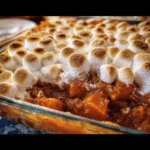
Sweet Potato Casserole with Marshmallows Recipe
Ingredients
- 3 pounds sweet potatoes peeled and cut into cubes
- ½ cup brown sugar packed
- ⅓ cup butter softened
- ½ teaspoon vanilla extract
- ¾ cup chopped pecans divided
- ¼ teaspoon cinnamon or to taste
- salt and black pepper to taste
- 2 cups miniature marshmallows
Instructions
- Preheat oven to 375°F. Grease a 9 x 13 pan.
- Place sweet potatoes in a pot of boiling water. Simmer for 15 minutes or until fork tender. Drain.
- In a large bowl (or in the pot the potatoes were cooked in), mash the sweet potatoes with brown sugar, butter, cinnamon, vanilla and salt & pepper.
- Fold in half of the pecans and spread into prepared pan.
- Sprinkle with the marshmallows and the remaining pecans.
- Bake for 25 minutes or until marshmallows are golden brown and potatoes are heated through.
Cultural Significance
The cultural significance of sweet potato casserole cannot be overstated. It is often served during major holidays, including Thanksgiving and Christmas, but its presence can also be felt during family gatherings and potluck dinners throughout the year. Each family tends to have its own unique twist on the recipe, reflecting personal preferences and regional influences. In some households, a crunchy pecan topping is favored, while others stick to the classic marshmallow topping.
Beyond individual families, sweet potato casserole has found its way into the menus of renowned chefs and restaurants, particularly in areas known for Southern cuisine. Chefs have taken the traditional recipe and infused it with contemporary twists, such as adding bourbon, spices, or gourmet toppings, elevating the dish while still paying homage to its roots. This adaptability has allowed sweet potato casserole to remain a relevant dish, bridging generations and bringing families together around the dinner table.
Nutritional Benefits
In addition to its rich history and cultural significance, sweet potato casserole boasts numerous nutritional benefits. Sweet potatoes are an excellent source of vitamins A and C, dietary fiber, and antioxidants. These nutrients contribute to overall health, supporting immune function and promoting healthy vision. When prepared with less sugar and healthier toppings, sweet potato casserole can be a wholesome addition to your family’s meals.
Furthermore, sweet potatoes are naturally gluten-free, making them a great option for those with dietary restrictions. The versatility of this dish allows for adjustments that can cater to various dietary preferences, including vegan or low-sugar versions, ensuring that everyone can enjoy this beloved casserole.
As we explore the world of sweet potato casserole, we uncover not just a recipe but a rich tapestry of history, culture, and tradition that continues to evolve. This dish is a testament to the power of food to connect us with our past while nourishing our bodies in the present. Whether you’re preparing it for a holiday feast or a cozy family dinner, sweet potato casserole remains a beloved classic that brings warmth and joy to every table.
Essential Ingredients for Perfect sweet potato casserole
When it comes to crafting the perfect sweet potato casserole, the ingredients you choose can make all the difference. Not only do they contribute to the flavor and texture of the dish, but they also carry the essence of the culinary traditions from which this beloved dish originates. In this section, we will explore the essential ingredients you need, their roles, quality indicators, storage tips, and even some cost-effective alternatives to ensure your sweet potato casserole is a hit every time.
Essential Ingredients
Here is a complete list of the ingredients you’ll need to create a delectable sweet potato casserole:
- 4 large sweet potatoes (about 2 pounds)
- 1 cup granulated sugar
- 1/2 cup packed brown sugar
- 1/2 cup unsalted butter, melted
- 1/2 cup milk (whole or evaporated for richness)
- 2 large eggs
- 1 teaspoon vanilla extract
- 1 teaspoon ground cinnamon
- 1/2 teaspoon ground nutmeg
- 1/4 teaspoon salt
- 2 cups mini marshmallows (for topping)
Each ingredient plays a crucial role in creating that perfect blend of sweetness and creaminess that defines sweet potato casserole.
The sweet potatoes are, of course, the star of the show. Their natural sweetness and vibrant orange color not only lend themselves to a beautiful presentation but also provide a rich source of vitamins and nutrients. When selecting sweet potatoes, look for firm, smooth-skinned ones without any blemishes or soft spots. The skin should be a consistent orange hue, indicating ripeness. In season from late summer through early winter, sweet potatoes can often be found at local farmers’ markets, which is always a great option for quality and flavor.
Granulated and brown sugars balance the natural sweetness of the sweet potatoes, with the brown sugar adding a hint of caramel-like depth. The melted unsalted butter is essential for a creamy texture and rich flavor, while milk adds moisture and helps bind the ingredients together. Whole milk is often preferred for its creaminess, but if you’re looking for a richer flavor, consider using evaporated milk. Avoid using skim milk, as it can make the casserole too watery.
The addition of eggs acts as a binding agent, ensuring that your casserole holds together beautifully when served. Vanilla extract enhances the overall flavor profile, while spices like cinnamon and nutmeg introduce warmth and complexity. Don’t skip the salt; it heightens sweetness and balances the flavors. Finally, the marshmallows on top are a classic touch that adds a delightful gooey sweetness and a crunchy texture when toasted.
Shopping Tips
When shopping for your ingredients, consider buying seasonal produce, as it tends to be fresher and more flavorful. Sweet potatoes are typically available year-round, but peak season is from October to December. This is the best time to find them at their sweetest and most affordable prices. Don’t hesitate to check out local farms or farmers’ markets for organic options, which often have superior taste and nutritional value.
For the sugars, I recommend purchasing them in bulk if you’re planning to make multiple casseroles or other desserts. This can be a cost-effective option, and you’ll always have them on hand for baking. Store them in airtight containers to keep them fresh.
When it comes to butter and milk, opt for high-quality brands. Grass-fed butter, for example, has a richer flavor and can elevate your dish. If you can find organic milk, it’s also worth the investment for its superior taste.
Substitutions and Alternatives
Dietary restrictions shouldn’t prevent anyone from enjoying sweet potato casserole. Fortunately, there are many substitution options available. For those who are dairy-free, consider using coconut milk or almond milk in place of regular milk, and use a dairy-free butter alternative. Additionally, flax eggs or applesauce can replace traditional eggs in the recipe, ensuring a vegan-friendly dish.
If you’re looking to reduce sugar, consider using natural sweeteners like maple syrup or honey. They will impart a different flavor but can still work beautifully in the casserole. For a lower-calorie option, you might try using sweeteners like stevia or monk fruit, though be sure to adjust the measurements according to the product’s sweetness level.
As for storage, sweet potatoes can be stored in a cool, dark place for several weeks. Once cooked, the casserole can be refrigerated for up to four days or frozen for up to three months. If freezing, be sure to cover it tightly with plastic wrap and aluminum foil to prevent freezer burn.
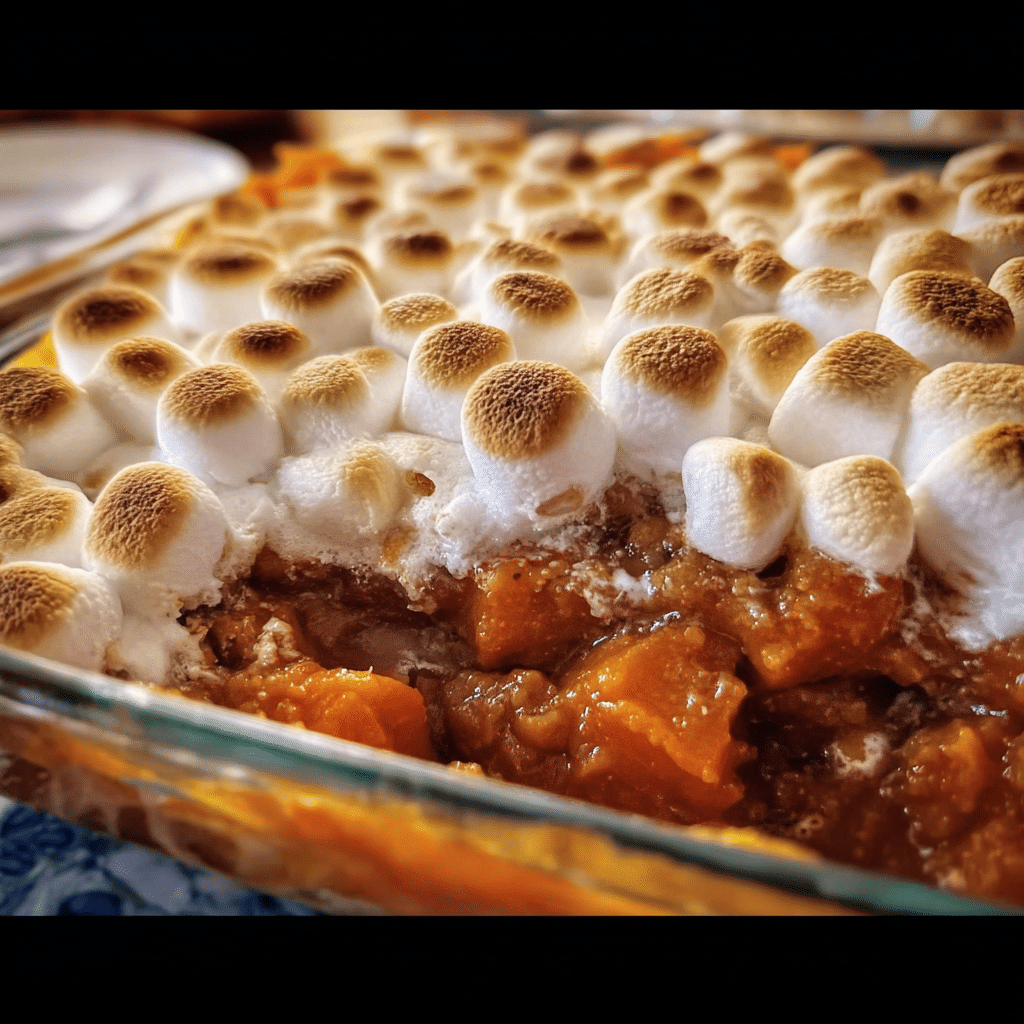
In conclusion, the ingredients you choose for your sweet potato casserole are not just about flavor; they reflect a blend of tradition, seasonal availability, and personal preference. With these tips and insights, you’ll be well-equipped to create a delicious dish that is sure to warm hearts and fill bellies. So gather your ingredients, and let’s get cooking!
Detailed Step-by-Step sweet potato casserole Cooking Instructions
Now that you have gathered all the essential ingredients for your sweet potato casserole, it’s time to delve into the step-by-step cooking process. I always find that following a clear set of instructions not only helps in achieving the perfect texture and flavor but also makes the cooking experience much more enjoyable. In this section, we will go through the preparation techniques, cooking methods, and final assembly of this delightful dish.
Preparation Steps
- Preheat Your Oven: Start by preheating your oven to 350°F (175°C). This ensures that your casserole cooks evenly and thoroughly.
- Peel and Cut the Sweet Potatoes: Using a sharp knife, peel the sweet potatoes and chop them into roughly equal-sized chunks, about 1-inch pieces. This helps them cook uniformly.
- Boil the Sweet Potatoes: Place the cut sweet potatoes in a large pot and cover them with water. Add a pinch of salt, then bring the pot to a boil over medium-high heat. Once boiling, reduce the heat to medium and let them simmer for about 15-20 minutes, or until they are fork-tender.
- Drain and Cool: After boiling, drain the sweet potatoes in a colander and let them cool slightly before transferring them to a large mixing bowl.
- Mash the Sweet Potatoes: Using a potato masher or a fork, mash the sweet potatoes until they are smooth and creamy. This is where you can let your personality shine—some prefer a few chunks for texture, while others like it completely smooth.
- Add the Other Ingredients: To the mashed sweet potatoes, add the granulated sugar, brown sugar, melted butter, milk, eggs, vanilla extract, cinnamon, nutmeg, and salt. Mix everything together until well combined. You can use an electric mixer on low speed for a fluffier consistency if you prefer.
Cooking Process
- Prepare the Baking Dish: Grease a 9×13-inch baking dish with butter or non-stick spray. This will prevent your casserole from sticking and make for easy cleanup.
- Pour the Mixture: Carefully pour the sweet potato mixture into the greased baking dish, smoothing the top with a spatula. This ensures even cooking and a beautiful presentation.
- Add the Marshmallows: Sprinkle the mini marshmallows evenly over the top of the sweet potato mixture. This classic topping is what makes sweet potato casserole a favorite at holiday gatherings.
- Bake: Place the baking dish in the preheated oven and bake for 30 minutes. Keep an eye on the marshmallows; they should puff up and turn golden brown, creating that irresistible toasted effect.
Final Assembly
- Check for Doneness: After baking, check that the casserole is heated through by inserting a knife into the center. It should come out warm. If you prefer a firmer texture, you can leave it in for an additional 5-10 minutes.
- Let it Rest: Once out of the oven, allow the casserole to rest for about 10-15 minutes before serving. This helps the flavors meld together and makes it easier to serve.
- Serve and Enjoy: Scoop generous portions into bowls and watch as your friends and family dive in! The warm, sweet, and creamy flavors are sure to evoke smiles and satisfaction.
Throughout this entire process, be mindful of the sensory cues. The aroma of sweet potatoes mingling with spices should fill your kitchen, hinting at the deliciousness to come. Look for visual cues as well; the marshmallows should be perfectly toasted, with a golden hue and a slightly crispy texture on top.
Common mistakes often come from overcooking sweet potatoes, which can lead to a watery casserole. Remember, you want them fork-tender but not mushy. If you’re making this for a crowd, consider prepping the sweet potatoes a day ahead. Just store them in the fridge after mashing and combine them with the other ingredients right before baking.
In terms of equipment, a quality potato masher or electric mixer will serve you well in this recipe. If you don’t have a baking dish, any oven-safe dish will work; just ensure it’s appropriately sized to hold your mixture. And lastly, always double-check your oven temperature for accuracy, as some ovens can run hot or cold, affecting your bake time.
With this detailed guide, you’re now equipped to create a sweet potato casserole that will not only impress your guests but also become a cherished tradition in your household. So get those ingredients prepped, and let the magic of cooking begin!
Professional Tips and Techniques for sweet potato casserole
When it comes to crafting the perfect sweet potato casserole, the journey from raw tubers to a beautifully baked dish is truly an art form. With a few professional tips and techniques, you can elevate your sweet potato casserole from everyday to extraordinary. Here are some insider secrets that will help you create a dish that not only tastes divine but also impresses your family and friends.
Professional Techniques
One of the first steps in making an exceptional sweet potato casserole is selecting the right sweet potatoes. Look for firm, smooth-skinned potatoes that feel heavy for their size. The most common varieties used in casseroles are the orange-fleshed sweet potatoes, known for their sweetness and creamy texture when cooked. To get the best flavor, you can roast them instead of boiling. Roasting caramelizes the natural sugars, enhancing the sweet flavor and providing a richer taste.
After roasting, allow the sweet potatoes to cool slightly before peeling. The skin should come off easily, and you’ll be left with the sweet, luscious flesh. For a smooth casserole, I recommend using a potato ricer or a food processor to mash the sweet potatoes. This technique avoids lumps and gives your casserole a silky texture that will have your guests coming back for seconds.
Another professional tip is to add a pinch of salt to your sweet potato mixture. It may seem counterintuitive to add salt to a sweet dish, but it enhances the overall flavor and balances the sweetness. You can also experiment with spices like cinnamon, nutmeg, or even a hint of cayenne for those who enjoy a little kick.
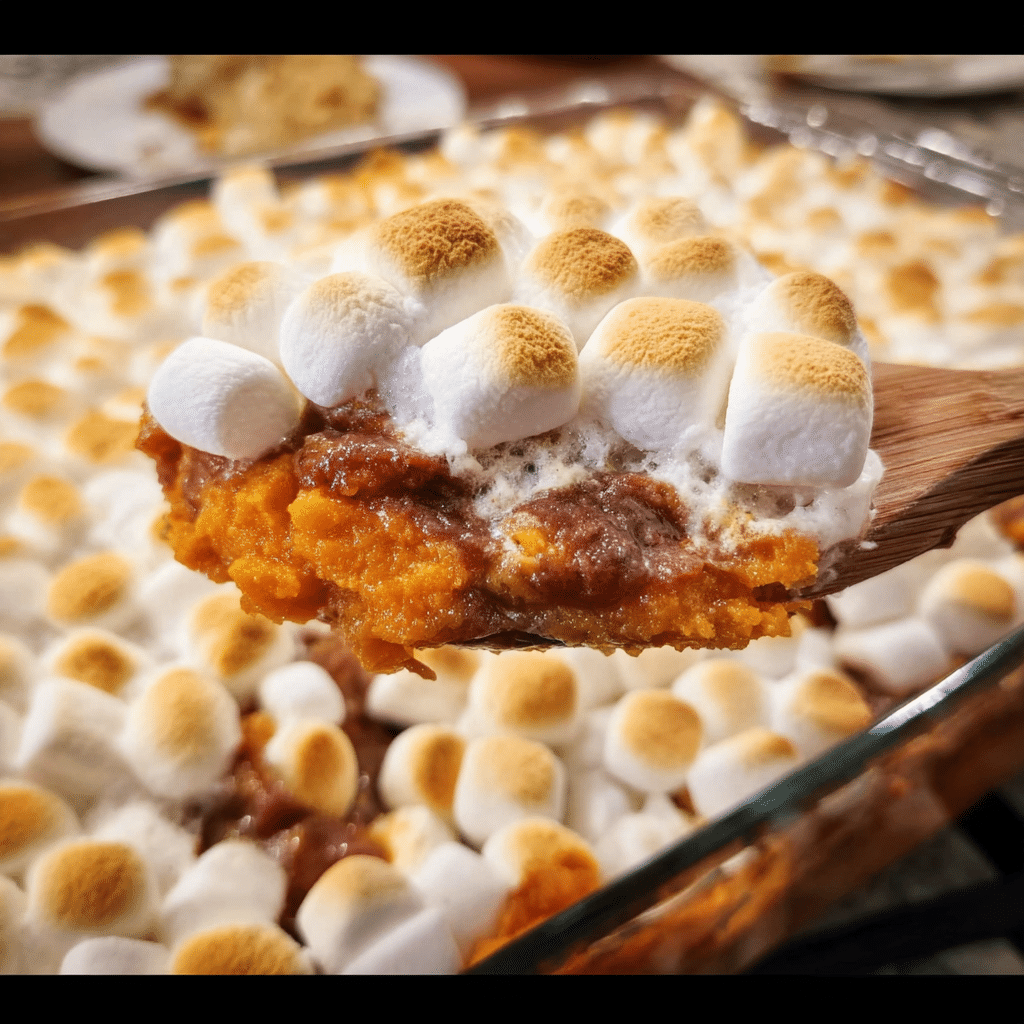
Troubleshooting Guide
Even the best cooks can run into problems when making sweet potato casserole. One common issue is a runny casserole. This can happen if you add too much liquid to the mixture, so be cautious with additions like milk or cream. If you find yourself with a watery mixture, consider adding a tablespoon of cornstarch or flour to thicken it up.
Another potential pitfall is overcooking the casserole, which can lead to a dry texture. To avoid this, check for doneness around the 30-minute mark. A toothpick inserted into the center should come out clean but not dry. If the top is browning too quickly, you can cover it with aluminum foil for the last few minutes to prevent burning.
Presentation Tips
Once your sweet potato casserole is baked to perfection, presentation is key. Transfer your casserole to a beautiful serving dish that complements your dining table. A rustic ceramic dish or a sleek glass baking dish can add a touch of charm. For an elegant finish, sprinkle some toasted pecans or mini marshmallows on top right before serving. You can even use a kitchen torch to give the marshmallows a light golden color for that perfect toasted look.
Pairing your sweet potato casserole with the right beverages can also enhance the meal. A light, fruity white wine like a Riesling or a slightly sweet Moscato pairs beautifully with the sweetness of the dish. If you prefer non-alcoholic options, consider serving a spiced apple cider or a homemade ginger ale for a refreshing contrast to the rich flavors of the casserole.
Lastly, don’t forget about meal prep and scaling your recipe. Sweet potato casserole is a fantastic make-ahead dish. You can prepare it a day in advance and store it in the refrigerator. Just be sure to cover it tightly with plastic wrap or aluminum foil. When you’re ready to bake it, allow it to sit at room temperature for about 30 minutes before putting it in the oven. If you need to scale your recipe up or down, simply adjust the ingredient quantities while keeping the same baking time in mind. A larger casserole may require a few extra minutes in the oven, while a smaller one might bake more quickly. Always keep an eye on it!
Creative Variations and Adaptations of sweet potato casserole
Sweet potato casserole is such a versatile dish, and while the classic version with marshmallows is beloved, there are countless creative variations that can take this dish to new heights. Whether you’re looking to adapt the recipe for dietary restrictions, seasonal ingredients, or simply want to try something new, the possibilities are endless!
Seasonal Variations
One of the best ways to keep your sweet potato casserole exciting is to incorporate seasonal ingredients. In the fall, consider adding chopped apples or pears for a fruity twist that complements the sweet potatoes beautifully. A sprinkle of fresh rosemary or sage can also add a delightful aromatic quality that evokes the essence of the season. During the spring, you might swap in fresh herbs like basil or mint for a fresher take on the dish.
During the holiday season, think about adding cranberries or pomegranate seeds for a burst of color and tartness. Not only do these fruits add a lovely visual contrast, but they also provide a refreshing balance to the sweetness of the casserole. You can even create a layered casserole by alternating layers of sweet potatoes and fruits, which makes for an eye-catching presentation.
Dietary Adaptations
In today’s diverse culinary landscape, accommodating dietary preferences and restrictions is more important than ever. Thankfully, sweet potato casserole can easily adapt to various diets. For a keto-friendly version, replace the sugar with a sugar substitute and consider using coconut cream instead of milk for a rich and creamy texture. You can also incorporate nuts like crushed pecans or almonds for added crunch, which is a fantastic way to add healthy fats.
If you’re catering to vegan guests, simply omit the eggs and dairy. Using a flaxseed mixture as a binding agent works wonders in keeping your casserole together. Additionally, coconut milk can provide a creamy base that’s completely plant-based. For gluten-free eaters, ensure that any added ingredients, like marshmallows, are certified gluten-free. This way, everyone can enjoy this delicious dish without worry!
Creative Twists
For those who love to experiment in the kitchen, consider adding international flavors to your sweet potato casserole. A dash of curry powder or cumin can infuse the dish with a warm, earthy flavor that contrasts beautifully with the sweetness of the potatoes. Alternatively, a touch of maple syrup paired with a sprinkle of bacon bits creates a sweet-savory combo that is simply irresistible.
Don’t forget about alternative cooking methods! While the traditional oven-baked casserole is delicious, you can also make sweet potato casserole in a slow cooker. This method allows the flavors to meld beautifully over low heat while you go about your day. Simply combine all your ingredients in the slow cooker, set it on low for about 4-6 hours, and you’ll have a delightful dish waiting for you at dinnertime.
If you find yourself with leftovers, don’t fret! Transform them into sweet potato pancakes for a hearty breakfast or use them as a filling for savory empanadas. The possibilities are truly endless when it comes to reinventing this classic dish.
With these creative variations and adaptations, sweet potato casserole can be tailored to fit any occasion or dietary need. Whether you’re sticking to tradition or experimenting with new flavors, this dish is sure to remain a favorite at your table.
Storage, Reheating, and Meal Prep for sweet potato casserole
When it comes to making a delicious sweet potato casserole, one of the most important aspects to consider is how to properly store it. Sweet potato casserole can be a delightful addition to any meal, especially during the holiday season. However, knowing how to store, reheat, and meal prep this dish can make all the difference in preserving its flavor and texture. Let’s dive into the ins and outs of storage, reheating, and meal prep for sweet potato casserole, ensuring you can enjoy it to the fullest.
Short-term Storage
After whipping up a batch of sweet potato casserole, you might find yourself with more than you can eat in one sitting. No worries! The first step in short-term storage is to allow your casserole to cool completely. Placing a hot dish in the refrigerator can raise the temperature inside, which is not safe for food storage.
Once cooled, transfer your sweet potato casserole into an airtight container. If you’re using a glass baking dish, you can cover it tightly with plastic wrap or aluminum foil. Ensure that the cover is secure to prevent any unwanted odors from mingling with your casserole.
In the refrigerator, your sweet potato casserole can last for about 3 to 5 days. If you’re planning to enjoy it within this timeframe, there’s no need to freeze it. Just make sure to keep an eye on the expiration of your ingredients, as some might have shorter shelf lives, which could affect your casserole.
Freezing and Long-term Storage
For those who want to enjoy their sweet potato casserole weeks or even months later, freezing is a fantastic option. To freeze your casserole, you’ll want to prepare it as you normally would but stop just before baking it. This way, you can bake it fresh later on. Once your casserole is assembled, cover it tightly with plastic wrap and then with aluminum foil to prevent freezer burn. It’s also a good idea to label it with the date and contents.
When you’re ready to eat your frozen casserole, it’s crucial to thaw it properly. The best method is to move it from the freezer to the refrigerator and allow it to thaw overnight. This gentle thawing helps maintain the texture and flavor of your sweet potato casserole. Once thawed, you can bake it at the usual temperature for about 30 to 45 minutes or until heated through.
Frozen sweet potato casserole can last for about 2 to 3 months in the freezer. Just make sure to check for any freezer burn or signs of spoilage before baking. If you find any ice crystals forming, it might be best to discard it.
Reheating Best Practices
Reheating your sweet potato casserole can sometimes be tricky, as you want to maintain its creamy texture and flavors. The best method for reheating is in the oven. Preheat your oven to 350°F (175°C). If your casserole was stored in the refrigerator, you can bake it directly without thawing. Cover the dish with foil to prevent it from browning too much on top, and heat for about 20 to 30 minutes. You can remove the foil in the last few minutes to allow the marshmallows to toast slightly, creating that beautiful golden-brown finish.
If you are reheating a frozen casserole, it’s best to thaw it overnight in the refrigerator and proceed as mentioned above. However, if you’re in a hurry, you can reheat from frozen; just adjust your cooking time to about 50 to 60 minutes, checking for doneness.
Another method for reheating is using a microwave, although this can sometimes lead to a less desirable texture. If you choose this route, transfer a portion to a microwave-safe bowl, cover it with a damp paper towel, and heat in 30-second intervals, stirring in between, until warmed through. This method works best for single servings rather than the whole casserole.
When it comes to meal prep, consider making a double batch of your sweet potato casserole. You can serve one fresh and freeze the other for a later date. This strategy not only saves time but also ensures that you always have a comforting dish on hand for unexpected guests.
Lastly, always remember food safety considerations. Be sure to refrigerate or freeze your casserole within two hours of cooking to avoid the risk of bacterial growth. If the casserole has been left out at room temperature for more than two hours, it’s best to discard it. Staying mindful of these guidelines will ensure that your sweet potato casserole remains both delicious and safe to eat.
In conclusion, understanding the best practices for storing, reheating, and meal prepping your sweet potato casserole can elevate your cooking experience. With these tips, you’ll be able to enjoy this delightful dish whenever the craving strikes!
Nutritional Benefits and Health Information
When we think of comfort food, few dishes hit the mark quite like sweet potato casserole. Not only is it a staple at holiday gatherings, but it also boasts a variety of nutritional benefits that can make it a healthy addition to your meals. In this section, we’ll delve into the nutritional profile of sweet potato casserole, explore its health benefits, and discuss dietary considerations to help you enjoy this dish guilt-free.
Nutritional Profile
The base of any sweet potato casserole is, of course, sweet potatoes. These vibrant, orange tubers are packed with nutrients. A typical serving of sweet potato casserole (about 1 cup) contains approximately:
- Calories: 250-300 (depending on added ingredients)
- Carbohydrates: 40-50g
- Protein: 3-5g
- Fat: 10-15g
- Fiber: 4-6g
- Sugar: 10-15g
Sweet potatoes are an excellent source of complex carbohydrates, which provide sustained energy without the crash associated with refined sugars. They are also rich in dietary fiber, which aids in digestion and helps maintain a healthy gut.
In addition to macronutrients, sweet potatoes are a powerhouse of vitamins and minerals. They are particularly high in:
- Vitamin A: One serving can provide over 400% of your daily value, primarily in the form of beta-carotene, which is essential for eye health.
- Vitamin C: Important for immune function and skin health.
- Manganese: A mineral that plays a role in metabolism and bone formation.
- Potassium: Vital for heart health and regulating blood pressure.
When marshmallows, brown sugar, or butter are added to the casserole, they do increase the calorie count and sugar content. However, there are ways to modify the recipe to enhance its nutritional profile while still maintaining that classic flavor.
Health Benefits
Beyond just being delicious, sweet potato casserole offers several health benefits. The high fiber content can help regulate blood sugar levels, making it a suitable option for those managing diabetes when consumed in moderation. The beta-carotene in sweet potatoes, which gives them their vibrant color, is an antioxidant that helps combat free radicals in the body, potentially reducing the risk of chronic diseases.
Additionally, sweet potatoes have anti-inflammatory properties. This can be particularly beneficial for individuals with inflammatory conditions, as they may help reduce symptoms. The presence of vitamins and minerals also supports overall well-being, assisting with everything from immune function to skin health.
Dietary Considerations
When preparing sweet potato casserole, it’s essential to consider various dietary needs. Many traditional recipes use dairy, which can be an issue for lactose-intolerant individuals or those following a vegan diet. Fortunately, there are numerous alternatives available. For example, coconut milk or almond milk can be used instead of cow’s milk, and vegan butter can replace regular butter without sacrificing flavor.
For those monitoring their sugar intake, consider using natural sweeteners like maple syrup or honey in moderation, or even reducing the amount of sugar altogether. You can also enhance the natural sweetness of the sweet potatoes by adding spices like cinnamon or nutmeg, which will complement the dish beautifully.
In terms of gluten-free diets, sweet potato casserole is inherently gluten-free, making it a perfect option for gatherings where gluten-free options are needed. Just be cautious of any toppings or additional ingredients that may contain gluten.
To further compare sweet potato casserole with similar dishes, consider traditional mashed potatoes. While both are delicious, sweet potatoes typically offer more nutrients, particularly in terms of vitamin A content. However, mashed potatoes can be prepared in healthier ways as well. Ultimately, it’s all about balance and moderation.
To summarize, the nutritional benefits of sweet potato casserole are numerous, making it a dish that can be enjoyed without guilt. By understanding its nutritional profile and how to make modifications, you can savor this comforting dish while supporting your health objectives. Whether you’re serving it at a holiday feast or enjoying it on a cozy night in, sweet potato casserole is a dish that nourishes both the body and the soul.
Frequently Asked Questions About Sweet Potato Casserole
Best sweet potato casserole with marshmallows
The best sweet potato casserole with marshmallows combines creamy, velvety sweet potatoes with a perfectly toasted layer of marshmallows on top. To achieve this, start by boiling or roasting the sweet potatoes until they are tender, then mash them with butter, brown sugar, and a splash of vanilla extract for extra flavor. For the topping, use mini marshmallows, which melt evenly and create that delightful gooey texture. Bake the casserole until the marshmallows are golden brown, ensuring they don’t burn by keeping an eye on them in the last few minutes. This dish pairs beautifully with savory holiday meals, making it a crowd-pleaser.
Easy sweet potato casserole with marshmallows
For an easy sweet potato casserole with marshmallows, you can simplify the process by using canned sweet potatoes, which require minimal prep time. Just drain them, mash them with butter, brown sugar, cinnamon, and a splash of milk until smooth. Spread the mixture in a baking dish, top generously with mini marshmallows, and bake until the marshmallows are melted and golden. To save even more time, you can prepare the casserole a day in advance and store it in the refrigerator, then bake it right before serving. This easy recipe ensures you spend less time cooking and more time enjoying your meal.
Pioneer Woman sweet potato casserole with marshmallows
The Pioneer Woman’s sweet potato casserole with marshmallows is a delightful twist on the classic dish, emphasizing comfort and flavor. Ree Drummond typically uses a blend of sweet potatoes and regular potatoes for added creaminess, along with a touch of orange juice or zest to brighten the flavor. She often combines marshmallows with a crunchy pecan topping for a delightful texture contrast. To replicate her style, consider adding a pinch of nutmeg or ginger to the sweet potato mixture for a warm spice note. Follow her baking instructions closely for the perfect golden marshmallow topping that adds a beautiful finish to the dish.
Sweet potato casserole with marshmallows and pecans
Combining marshmallows and pecans in your sweet potato casserole adds both sweetness and a satisfying crunch. Begin by preparing your sweet potatoes with butter, brown sugar, and a hint of vanilla, then fold in chopped pecans to the mixture before transferring it to your baking dish. For the topping, you can either mix pecans with the marshmallows or sprinkle them separately on top for a layered texture. Bake until the marshmallows are golden brown, and the pecans are toasted, which enhances their flavor. This combination not only elevates the dish but also provides a wonderful nutty flavor that complements the sweetness of the sweet potatoes.
Conclusion: Mastering the Perfect sweet potato casserole
Creating the perfect sweet potato casserole is more than just following a recipe—it’s about understanding the techniques, ingredients, and cultural significance behind this beloved dish. Throughout this comprehensive guide, we’ve explored everything from the historical origins to modern variations, ensuring you have all the knowledge needed to make this recipe your own.
Whether you’re a beginner cook or an experienced chef, the techniques and tips we’ve shared will help you create a sweet potato casserole that’s not only delicious but also meaningful. Remember that cooking is a journey of discovery, and each time you make this dish, you’ll learn something new.
We encourage you to experiment with the variations we’ve discussed, adapt the recipe to your dietary needs, and most importantly, share it with the people you love. Food has the incredible power to bring people together, and Sweet Potato Casserole with Marshmallows is the perfect dish to create lasting memories around your dinner table.

